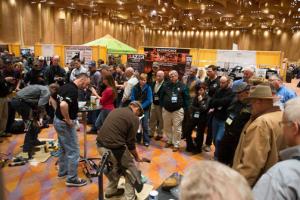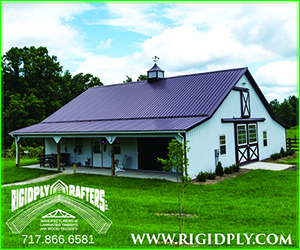The American Farriers Journal hosted the 13th annual International Hoof-Care Summit in Cincinnati, Ohio. The summit officially got underway February 2-5, 2016, but there were also educational opportunities before the summit began.
The summit offered four days of in-depth hoof care learning opportunities with top experts from around the world. Members of the American and Canadian Associations of Professional Farriers could earn continuing education credit hours. Prior to start of the summit, on February 2, Vettec offered two special hands-on clinics for attendees to try out various Vettec materials for hoof care applications. Also on Tuesday, February 2, SmartPak offered nutrition advice, relative to hoof health, with Jessica Normand, Senior Director for Equine Health, and Danvers Child, CJF.
Keynote speakers included Dr. Hans Castelijns, veterinarian and farrier from Cortona, Italy; Dr. Renate Weller, researcher and veterinarian from the Royal Veterinary College in England; Bob Pethick, farrier from Califon, New Jersey; and Mitch Taylor, owner/operator of the Kentucky Horseshoeing School in Richmond, Kentucky.
There were eight general sessions, 15 hoof-care classrooms, 24 hoof-care roundtable discussions, and 24 how-to clinics at the summit. In addition, a vast trade show offered the newest 2016 hoof care products coming on the market.
Mark Aikens, Farrier, Norwich, England; Dean Moshier, Farrier, Delaware, Ohio; and Pete Healey, Farrier, San Los Obispo, California were panel discussants on how to build a better practice with backyard horses. “Did you know that the trot is the most common pace used when analyzing a horse’s gait? The pace is symmetrical with diagonal limbs swinging in a synchronic rhythm,” said Norwich, England, farrier Mark Aikens.
Dr. Mark Silverman, Veterinarian/Farrier, Rancho Santa Fe, Calif. demonstrated how he and the resident farrier approached repairing the hoof wall, using samples from his California clinic.
Steve Foxworth, Farrier, Berthoud, Colo. Explained the basic questions that are critical for understanding the value of hoof mapping. Foxworth’s hoof mapping protocol consists of just 3 lines: the widest part of the foot, the tip of P3, and breakover. The minimum number of lines simplifies hoof mapping and makes it easier to focus on the foot.
This leads to the question: what is breakover? “Breakover is popular term in farriery, yet what does it really mean? Definitions of breakover vary widely, contributing to oversimplification and undermining real gait analysis,” according to Huntsville, Alabama farrier Dr. Mike Miller. “If you ask five farriers, you’ll probably get as many definitions. Everyone has been told about breakover from the time you were a farrier student, an apprentice, when you worked with a mentor,” says Miller, who not only is a farrier, but also serves human patients as an orthopedic surgeon. “Everyone has an idea and are convinced they know what it is.”
However, Miller is convinced that no one really knows what it is. “What you think it is, probably doesn’t exist at all,” Miller says. “The problem with focusing on breakover is that you’re taking away from what really matters, which is a very complicated, biomechanical animal that weighs 1,100 pounds and responds to tremendous forces — and you are working on the wrong end of a chain.”
Curtis Burns from Polyflex, Wellington, Florida; Steve Kraus, Head of Farrier Services, Cornell University, Ithaca, N.Y.; and Pat Reilly, New Bolton Center, University of Pennsylvania, Kennett Square, Pa. participated in a panel discussion on how user error contributes to misconceptions of the use of adhesives use and user error is the cause a poor outcome for the horse. For example, “Do adhesives harm hoof wall? Cornell University's head farrier Steve Kraus maintains it doesn’t. ‘What ruins hoof wall is improper removal of the application that has been glued to the foot,’ Kraus says.”
Thilo Pfau, Researcher at the Royal Veterinary College in England, gave advice on how farriers can help horse owners gain insight into assessing their horse’s gait and re-evaluating the soundness of their horses.
Vern Dryden, Veterinarian/Farrier, Rood & Riddle Equine Hospital, Lexington Ky. discussed considerations about footing when working with clients’ horses. “The composition of the surface and the interaction with the foot, coupled with the physical demands of the horse determine the proper shoeing protocol,” said Dryden.
There were recognitions of outstanding achievement at the summit, as well. Rustin Moore, Scott Pleasant, Florian Buchner, Steve Kraus, Steve Bloom and Jim Blurton Farrier Products were inducted into the International Equine Veterinarian Hall Of Fame and the International Horseshoeing Hall Of Fame.
Late last summer, the farrier world lost one of its best and brightest when Red Renchin passed away at age 70. To honor the Hall Of Fame shoer and American Farriers Journal technical editor, the American Association of Professional Farriers and AFJ teamed up to create the Robert “Red” Renchin Distinguished Leadership Award. The award is a Waterford crystal vase that rests on a wooden base, displaying the names of each year’s recipients. The first recipient of the AAPF Robert “Red” Renchin Distinguished Leadership Award was, of course, the late Robert “Red” Renchin.
Triple Crown Farrier
Since 2015was a tremendous year in the equine industry, with the first Triple Crown winner in 36 years, plus American Pharoah winning the Breeder’s Cup Classic, AFJ Executive Editor Jeremy McGovern and AFJ Editor and Publisher Frenk Lessiter recognized the outstanding footcare work that Arcadia, California farrier Wes Champagne provided for the legendary American Pharoah.
“It takes a lot of hard work to be a farrier,” Champagne said. “You have to want it like you want to breathe.”
Champagne says that American Pharoah didn’t receive special treatment from his farrier. “I treat him like any horse that I treat,” Champagne says. “I do the best that I can, because I know if he goes on to win a competition, he brings other horses to that barn, which makes more work for all of us.”
Throughout the summit American Farriers Journal editors tweeted and posted information on facebook about each day’s educational forums. A summary of those posts is available on the website: www.americanfarriers.com.
[http://www.americanfarriers.com/articles/8063-international-hoof-care-summit-social-media-recap] Or view the facebook posts here: https://www.facebook.com/InternationalHoofCareSummit/
The summit offered four days of in-depth hoof care learning opportunities with top experts from around the world. Members of the American and Canadian Associations of Professional Farriers could earn continuing education credit hours. Prior to start of the summit, on February 2, Vettec offered two special hands-on clinics for attendees to try out various Vettec materials for hoof care applications. Also on Tuesday, February 2, SmartPak offered nutrition advice, relative to hoof health, with Jessica Normand, Senior Director for Equine Health, and Danvers Child, CJF.
Keynote speakers included Dr. Hans Castelijns, veterinarian and farrier from Cortona, Italy; Dr. Renate Weller, researcher and veterinarian from the Royal Veterinary College in England; Bob Pethick, farrier from Califon, New Jersey; and Mitch Taylor, owner/operator of the Kentucky Horseshoeing School in Richmond, Kentucky.
There were eight general sessions, 15 hoof-care classrooms, 24 hoof-care roundtable discussions, and 24 how-to clinics at the summit. In addition, a vast trade show offered the newest 2016 hoof care products coming on the market.
Mark Aikens, Farrier, Norwich, England; Dean Moshier, Farrier, Delaware, Ohio; and Pete Healey, Farrier, San Los Obispo, California were panel discussants on how to build a better practice with backyard horses. “Did you know that the trot is the most common pace used when analyzing a horse’s gait? The pace is symmetrical with diagonal limbs swinging in a synchronic rhythm,” said Norwich, England, farrier Mark Aikens.
Dr. Mark Silverman, Veterinarian/Farrier, Rancho Santa Fe, Calif. demonstrated how he and the resident farrier approached repairing the hoof wall, using samples from his California clinic.
Steve Foxworth, Farrier, Berthoud, Colo. Explained the basic questions that are critical for understanding the value of hoof mapping. Foxworth’s hoof mapping protocol consists of just 3 lines: the widest part of the foot, the tip of P3, and breakover. The minimum number of lines simplifies hoof mapping and makes it easier to focus on the foot.
This leads to the question: what is breakover? “Breakover is popular term in farriery, yet what does it really mean? Definitions of breakover vary widely, contributing to oversimplification and undermining real gait analysis,” according to Huntsville, Alabama farrier Dr. Mike Miller. “If you ask five farriers, you’ll probably get as many definitions. Everyone has been told about breakover from the time you were a farrier student, an apprentice, when you worked with a mentor,” says Miller, who not only is a farrier, but also serves human patients as an orthopedic surgeon. “Everyone has an idea and are convinced they know what it is.”
However, Miller is convinced that no one really knows what it is. “What you think it is, probably doesn’t exist at all,” Miller says. “The problem with focusing on breakover is that you’re taking away from what really matters, which is a very complicated, biomechanical animal that weighs 1,100 pounds and responds to tremendous forces — and you are working on the wrong end of a chain.”
Curtis Burns from Polyflex, Wellington, Florida; Steve Kraus, Head of Farrier Services, Cornell University, Ithaca, N.Y.; and Pat Reilly, New Bolton Center, University of Pennsylvania, Kennett Square, Pa. participated in a panel discussion on how user error contributes to misconceptions of the use of adhesives use and user error is the cause a poor outcome for the horse. For example, “Do adhesives harm hoof wall? Cornell University's head farrier Steve Kraus maintains it doesn’t. ‘What ruins hoof wall is improper removal of the application that has been glued to the foot,’ Kraus says.”
Thilo Pfau, Researcher at the Royal Veterinary College in England, gave advice on how farriers can help horse owners gain insight into assessing their horse’s gait and re-evaluating the soundness of their horses.
Vern Dryden, Veterinarian/Farrier, Rood & Riddle Equine Hospital, Lexington Ky. discussed considerations about footing when working with clients’ horses. “The composition of the surface and the interaction with the foot, coupled with the physical demands of the horse determine the proper shoeing protocol,” said Dryden.
There were recognitions of outstanding achievement at the summit, as well. Rustin Moore, Scott Pleasant, Florian Buchner, Steve Kraus, Steve Bloom and Jim Blurton Farrier Products were inducted into the International Equine Veterinarian Hall Of Fame and the International Horseshoeing Hall Of Fame.
Late last summer, the farrier world lost one of its best and brightest when Red Renchin passed away at age 70. To honor the Hall Of Fame shoer and American Farriers Journal technical editor, the American Association of Professional Farriers and AFJ teamed up to create the Robert “Red” Renchin Distinguished Leadership Award. The award is a Waterford crystal vase that rests on a wooden base, displaying the names of each year’s recipients. The first recipient of the AAPF Robert “Red” Renchin Distinguished Leadership Award was, of course, the late Robert “Red” Renchin.
Triple Crown Farrier
Since 2015was a tremendous year in the equine industry, with the first Triple Crown winner in 36 years, plus American Pharoah winning the Breeder’s Cup Classic, AFJ Executive Editor Jeremy McGovern and AFJ Editor and Publisher Frenk Lessiter recognized the outstanding footcare work that Arcadia, California farrier Wes Champagne provided for the legendary American Pharoah.
“It takes a lot of hard work to be a farrier,” Champagne said. “You have to want it like you want to breathe.”
Champagne says that American Pharoah didn’t receive special treatment from his farrier. “I treat him like any horse that I treat,” Champagne says. “I do the best that I can, because I know if he goes on to win a competition, he brings other horses to that barn, which makes more work for all of us.”
Throughout the summit American Farriers Journal editors tweeted and posted information on facebook about each day’s educational forums. A summary of those posts is available on the website: www.americanfarriers.com.
[http://www.americanfarriers.com/articles/8063-international-hoof-care-summit-social-media-recap] Or view the facebook posts here: https://www.facebook.com/InternationalHoofCareSummit/












